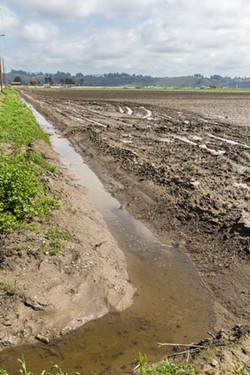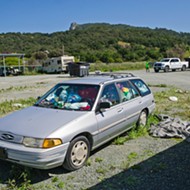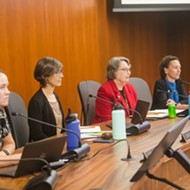Arroyo Grande Creek will undergo a two-stage sediment removal and levee repair process as county Public Works assesses post-rainstorm damage
By Bulbul Rajagopal[{
"name": "Newsletter Promo",
"id": "NewsletterPromo",
"class": "inlineCenter",
"insertPoint": "4",
"component": "15264767",
"requiredCountToDisplay": "0"
},{
"name": "Ad - Medium Rectangle CC01 - 300x250",
"id": "AdMediumRectangleCC01300x250",
"class": "inlineCenter",
"insertPoint": "8",
"component": "2963441",
"requiredCountToDisplay": "12"
},{
"name": "Ad - Medium Rectangle LC01 - 300x250",
"id": "AdMediumRectangleCC01300x250",
"class": "inlineCenter",
"insertPoint": "18",
"component": "2963441",
"requiredCountToDisplay": "22"
},{
"name": "Ad - Medium Rectangle LC09 - 300x250",
"id": "AdMediumRectangleLC09300x250",
"class": "inlineCenter",
"insertPoint": "28",
"component": "3252660",
"requiredCountToDisplay": "32"
}]
An estimated almost $7 million price tag for post-storm damage repairs hovers over Arroyo Grande Creek.
The series of winter rainstorms starting Jan. 9 wreaked havoc on San Luis Obispo County. The Arroyo Grande Creek swelled with an overabundance of water that broke through the south side of the creek levee that same day. A series of speedy fixes throughout the remainder of winter and spring temporarily plugged the levee, and it held for the rest of the wet season. Now that the land surrounding the creek channel is finally dry enough, county officials are left to deal with the additional damage and safeguard the future of the levee.
The plan is a two-part repair mission, and the county Board of Supervisors authorized both phases to proceed on June 20 and July 11, respectively.
Phase One is an attempt to remove 11,100 cubic yards of accumulated sediment and debris from the channel because it reduced the creek's capacity, especially downstream of the Union Pacific Railroad Bridge. It's expected to cost $1.8 million.
Phase Two anticipates long-term repairs for the levee by installing hydraulic barriers in different compromised portions to protect against seepage and more erosion. The county estimates this project to cost $4.9 million.
Brandon Zuniga, a water resources engineer for the Public Works Department, told New Times that clearing the sediment is critical because of an impending climate pattern that will heat up the atmosphere.
"Looking at projections for this coming winter, with the El Niño forming and expected to be a moderate to high El Niño event, we've got a lot of reason to go ahead and try to remove as much sediment that has accumulated since the WMP [waterway management plan] was constructed in 2019 and 2020," Zuniga said.
The management plan dates to 2010 and is a comprehensive set of actions designed to improve the capacity of the levee. Zuniga said that Public Works officials had to wait to remove sediment until the land near the creek channel was dry. Waiting for the driest part of the season is in accordance with the management plan, he added, so that there's minimal impact to endangered species—like the steelhead trout—in the creek.
"All of the emergency actions that we took, none of it involved sediment removal," he said. "There were debris jams that we removed, repairs to the levee structures that we did but when it's wet, that kind of sediment removal work is a bit harder to do."
Still, even the management plan—a documented effort to provide flood protection for up to a 20-year storm event in tandem with enhancing water quality and sensitive species—couldn't predict the extent of the damage.
"[The sediment removal work] doesn't quite fit with the waterway management program because the amount of sediment we're removing is larger than what it was designed as, especially since this year was so crazy," Zuniga said with a laugh.
The goal of the first phase is to restore freeboard space—the distance between the top of the levee and the water surface elevation—along different sections of the channel and bring it back to the level it was at during 2020 when the management plan was constructed.
"Under a 10-year flooding event, the water surface elevation should be 2 feet from the top of the levee," Zuniga said.
Removing debris is also urgent because the creek capacity at the Union Pacific Railroad Bridge decreased thanks to the sediment load. One of the identified alternatives that the management plan provided for 20-year flood protection was raising the levee by another foot.
"But if they raised the levee another foot on each side, they have to raise a variety of bridges ... Highway 1 Bridge, 22nd Bridge, and Union Pacific Railroad Bridge as well," Zuniga said. "The day that the levee breached, we saw flows well above the railroad trestle."
Another reason for the urgency: Lopez Lake is full.
"Our engineers have estimated that it will probably be around 87 percent capacity by the time we get to the winter season," he said. "Lopez Lake will likely spill again this coming winter season, so we have to get in there and try to restore capacity before that happens."
Sediment and debris removal work will begin over September and October, and Public Works staff must be out of the creek by Oct. 31, which marks the beginning of the rainy season. The construction schedule for levee repairs is yet to be determined.
Public Works has received a state earmark of $1.2 million for the Arroyo Grande Creek levee. It's also working with a Federal Emergency Management Agency (FEMA) project manager to receive more funding. Zuniga said his department expects to receive FEMA funding of at least a 75 percent price match.
Public Works is preparing for hypothetical financial scenarios too. If additional finances are required for both phases, the county Flood Control District and the creek's Water Conservation District plan to approach the Board of Supervisors for a loan. The Flood Control District is a separate entity from the county. There is a legal divide even though both are staffed by Public Works officials. That separation allows for the district and the county to have different grant and project managers, according to Zuniga.
Even though the original management plan was financed through money cobbled together from grants and taxes on property owners living in the flood control zone, Zuniga told New Times that Public Works is determined to create a funding scheme that's not too reliant on those property owners.
"That budget is not quite the largest, especially with Oceano being a disadvantaged community," he said. "We don't want to increase taxes; we're trying to find grant opportunities for anything that will help us provide more flood protection." Δ
Reach Staff Writer Bulbul Rajagopal at [email protected].
Latest in News
Comments
Showing 1-1 of 1
Readers also liked…
-

Coast Unified teachers upset over new position's salary and qualifications
Oct 20, 2022 -

SLO police identify alleged driver who hit and killed couple
Dec 22, 2022 -

When the levee breaks: Oceano residents, county officials walk a tightrope of regulations to manage Arroyo Grande Creek, which some say led to the levee's failure in January
May 18, 2023









